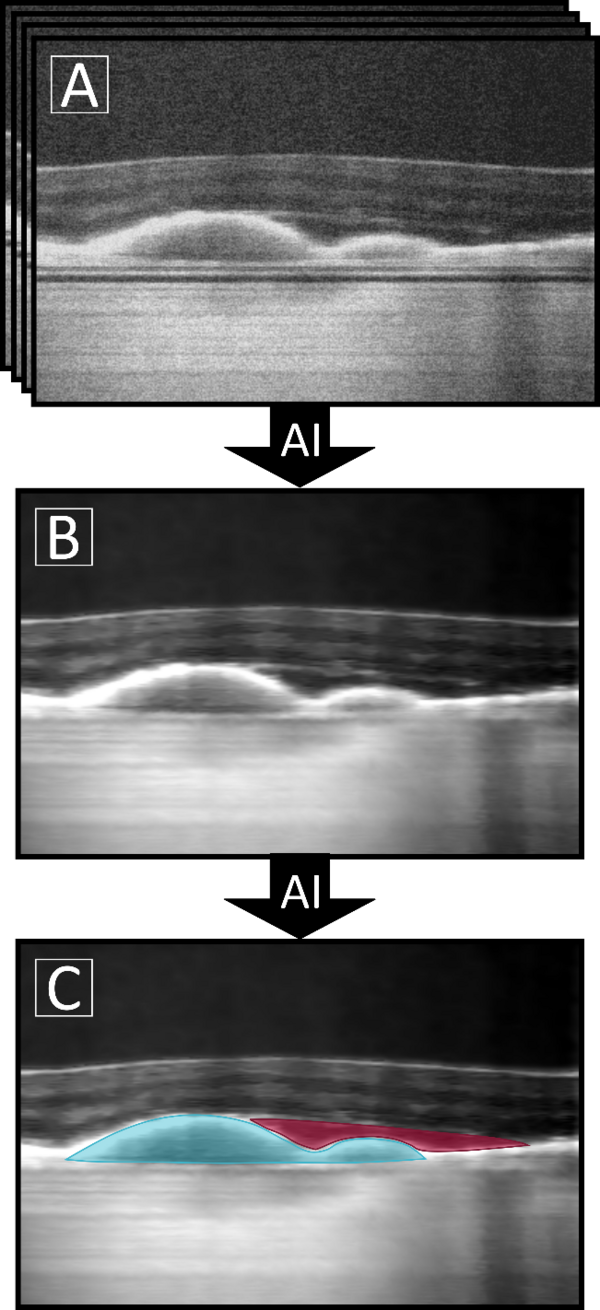Quality enhancement of Home-OCT images and improved automatic image analysis utilizing artificial intelligence
Within the project "Quality enhancement of Home-OCT images and improved automatic image analysis utilizing artificial intelligence", funded by the state of Schleswig-Holstein, methods of artificial intelligence (AI) and deep learning in particular are investigated as part of a cooperation between the Institute of Medical Informatics (IMI) at the University of Lübeck and Visotec GmbH in order to improve the quality of Home-OCT images both for evaluation by human observers and for automated segmentation of pathological changes involving the retina of the eye. The project is funded as part of the AI funding initiative ("KI-Förderinitiative") of the state of Schleswig-Holstein from 2022-2024.
Due to automated diagnostic options at the patient's home the technologically innovative and mobile Home-OCT (OCT: Optical Coherence Tomography) from Visotec GmbH enables an improvement in the therapy of age-related macular degeneration (AMD), which is the most common cause for loss of sight for people over 50 years of age in developed countries.
However, due to its compact and cost-effective design, the Home-OCT's medical images differ from the scans typically obtained by OCT systems used in clinical settings. In addition to a lower signal-to-noise ratio (SNR), Home-OCT scans also exhibit artifacts caused by the patient’s head or eye movements, which can cause horizontal signal defects in the image volume. As a consequence, diagnostic image interpretation and the associated identification or segmentation of AMD-specific biomarkers is impaired.
The main goal of the project is to increase the quality of Home-OCT images for diagnostic purposes by reducing noise effects and motion artifacts as well as by an AI-based combination of image information from different scans. In addition, it will be evaluated to what extent this quality enhancement creates an improved starting point for deep learning based segmentation and further analysis of AMD-specific biomarkers. Furthermore, regulatory aspects for an approval of the developed algorithms will be investigated by Visotec GmbH in cooperation with external partners.
Figure 1: Visualization of the quality enhancement process for Home-OCT images and an improved automatic image analysis using artificial intelligence.
A: A series of original images affected by image noise and artifacts
B: Visualization of a quality enhanced Home-OCT image generated from the original images
C: Illustration of the quality enhanced image superimposed with segmentation results for AMD-specific biomarkers
Team
M.Sc. Marc Rowedder
Prof. Dr. Heinz Handels
Partner
Helge Sudkamp
Tobias Neumann
Fa. Visotec GmbH, Lübeck

- Research
- AI und Deep Learning in Medicine
- Medical Image Processing and VR-Simulation
- Integration and Utilisation of Medical Data
- Sensor Data Analysis for Assistive Health Technologies
- Medical Image Computing and Artificial Intelligence
- Medical Data Science Lab
- Medical Deep Learning Lab
- Junior Research Group Diagnostics and Research of Movement Disorders
- Former Medical Data Engineering Lab
Contact person
Heinz Handels

Head of Institute
Gebäude 64, 2.OG
,
Raum 87
heinz.handels(at)uni-luebeck.de
+49 451 3101 5600

